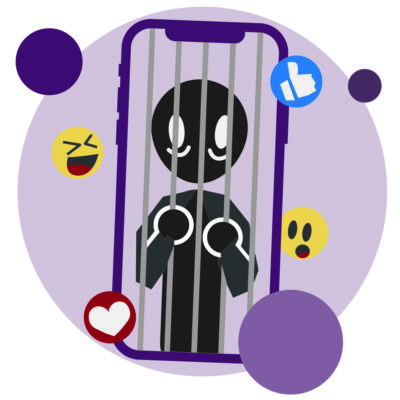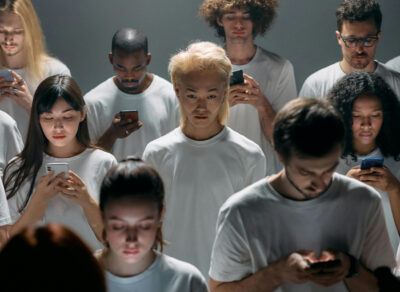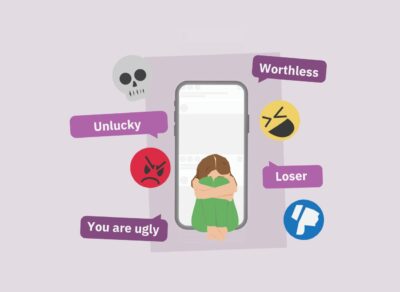 Are you only living a virtual life or a real one as well?
Are you only living a virtual life or a real one as well?
In the age of technological advancements, it is borderline inevitable to spend at least a part of our everyday lives in the virtual space. This phenomenon affects every generation, however, the impact is not always negative: to the necessary extent, we may use our devices for orientation, keeping in touch with others, or administration. The problems start when the use of our digital devices overshadows our human relationships and daily tasks, and gradually turns into an addiction, making us tense and irritable in their absence. Taking advantage of the opportunities provided by technology is not an issue, but letting them rule our life is. We should become conscious users.
Suffering from a behavioural addiction means losing control over an activity and performing it compulsively over and over again despite being aware of its harmful effects on the actor and their environment. Upon being triggered, a craving appears, which can only be decreased by performing the relevant activity.
 Internet addiction can take many shapes and forms. The addiction may be connected to one particular activity (e.g. using a social media platform) and associated problematic behaviours. Although adolescents and young adults are mostly affected, all age groups are endangered by such addictions. When one spends hours browsing profiles and scrolling through timelines, time spent with other activities, loved ones, and friends decreases. This may have a detrimental effect on one’s studies, workplace performance and genuine social relationships.
Internet addiction can take many shapes and forms. The addiction may be connected to one particular activity (e.g. using a social media platform) and associated problematic behaviours. Although adolescents and young adults are mostly affected, all age groups are endangered by such addictions. When one spends hours browsing profiles and scrolling through timelines, time spent with other activities, loved ones, and friends decreases. This may have a detrimental effect on one’s studies, workplace performance and genuine social relationships.
Why can’t we stop performing these activities then? As with other addictions, several motivations might influence our behaviour.
Social media usage is often prompted by seeking entertainment and information or fleeing from negative feelings. Visiting these platforms may also be motivated by a need for self-representation and belongingness. In the latter case, we crave social impulses and the formation of new relationships, while self-representation enables us to feel more popular or to display alternative selves. On social media platforms, we can tailor these selves the way we want to be seen by others. Those suffering from social anxiety are mostly prone to creating alternative, ideal selves that do not represent their everyday state.
The song ’Megosztasz vagy Megélsz’ (Divide or Get By) by Pancastic deals with the phenomenon of using filters, applications and other tools to present a more positive image on social media platforms.
We care about other people’s shared stories to varying extents. Those who wish to be popular or want to belong to a certain community may feel anxious about missing out, therefore they are prompted to browse social media sites more frequently. This phenomenon is called FOMO, the fear of missing out. When we browse other people’s posts and pictures, we tend to compare their projected reality and selves with ours. In these cases, it is important to realize that most people are likely to share idealized pictures of themselves instead of more accurate representations of their daily hardships and challenges. Without this awareness, the passive user may develop a negative self-image leading to dissatisfaction, or, in more serious cases, depression. Spending time on social media platforms is not inherently correlated to bad mood; what matters most is the problematic usage. Those who are prone to depression also have a higher proclivity for addictive usage since this activity becomes a mood management tool (e.g. providing distractions and cheerful impulses).
’Are You Lost In The Wood Like Me?’, an animation by Steve Cutts paints a gloomy but thought-provoking picture of digital device usage and the tipped balance between virtual and real life.
Multitasking
Multitasking means that we divide our attention and perform more than one activity at the same time. This might seem efficient, but multitasking decreases our attention span, our capacity to solve problems as well as our overall performance. Using several devices simultaneously has a detrimental effect on studying, work, and social relationships. The danger is further exacerbated if we are multitasking whilst driving or travelling on foot; dividing our attention in such ways may claim lives.
Cyberbullying
 Aside from addiction, another danger of the virtual world and incorrect social media usage is cyberbullying. Since this type of harassment happens through the internet it crosses the physical boundaries of schools and workplaces, enabling the bully to enter our previously safe places with their posts and messages. In many cases, the bully is anonymous, making it even harder to defend against these attacks. We all tend to communicate more aggressively online than in the real world. Whatever is shared on the internet (e.g. a cringey or embarrassing video, photo or text) may resurface in the most unexpected situations during our lives.
Aside from addiction, another danger of the virtual world and incorrect social media usage is cyberbullying. Since this type of harassment happens through the internet it crosses the physical boundaries of schools and workplaces, enabling the bully to enter our previously safe places with their posts and messages. In many cases, the bully is anonymous, making it even harder to defend against these attacks. We all tend to communicate more aggressively online than in the real world. Whatever is shared on the internet (e.g. a cringey or embarrassing video, photo or text) may resurface in the most unexpected situations during our lives.
What we share on the internet is potentially indelible, therefore we need to consider how it may affect us or others.
Cyberbullying can lead to increased stress levels, social anxiety, substance use, depression, suicidal thoughts and attempts, thus it must be taken seriously.
Health problems
Excessive internet usage may lead to health problems such as attention and sleep disorders. It often contributes to physical problems such as neck, shoulder and back pain, headaches, visual impairment and overweight.
Are you only living a virtual life or a real one as well?

The most meaningful things in life happen offline. If we can truly be present there, we don’t need to worry about missing out.
Mindfulness means being aware of the present, thus being able to fully experience the moment and the activities we engage in.
Picture1: cottonbro studio: https://www.pexels.com/hu-hu/foto/emberek-okostelefon-kapcsolat-fuggoseg-8088452/
Picture2: RDNE Stock project: https://www.pexels.com/hu-hu/foto/par-szeretet-szerelem-okostelefon-6414839/
Videos: YouTube